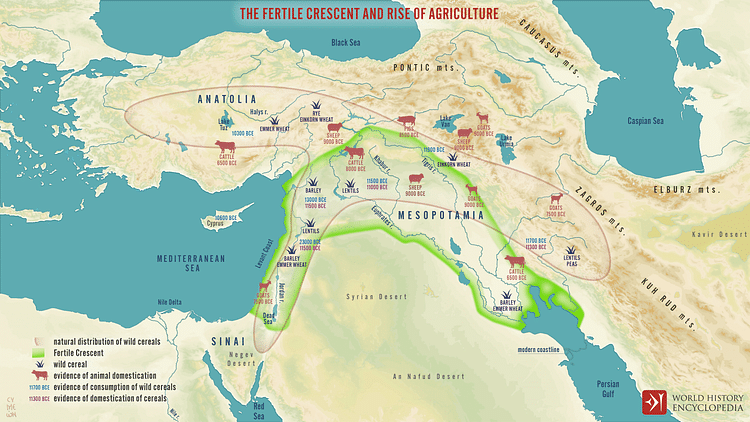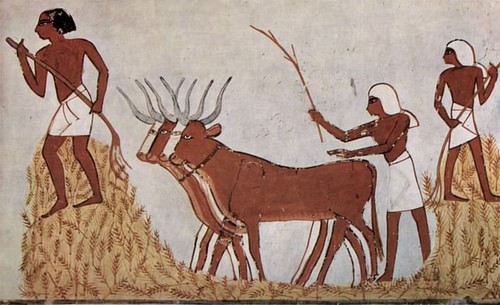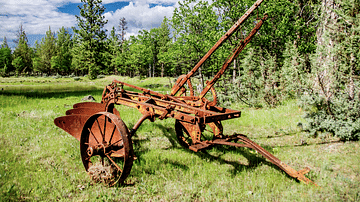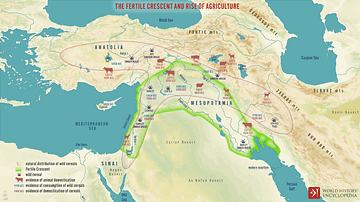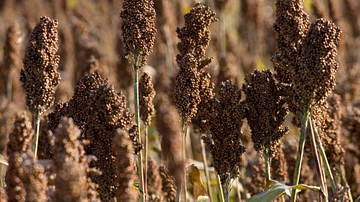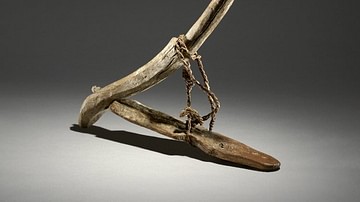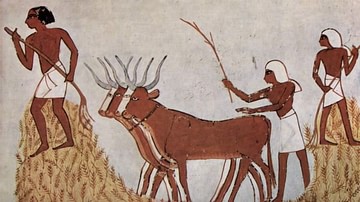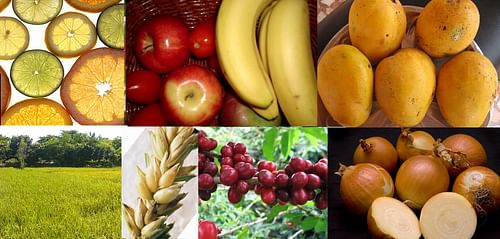
The First Agricultural Revolution, beginning c. 12-20,000 years ago, was characterized by the emergence of different agricultural systems in different parts of the world, whose common trait was the use of native species. Although agriculture is commonly believed to have originated in the Near East between 12,000 and 8000 years ago, agriculture actually developed independently in several regions, stemming from their respective native species.
The Emergence of Agriculture
The shift from a hunter-gatherer lifestyle to a more settled existence supported by agriculture happened over a few thousand years between c. 12,000 and 20,000 years ago. At that time, the overall population of the planet may have ranged from four to eight million, scattered all over the continents as a consequence of migrations caused by glaciations and the reshaping of the continents at the end of the Ice Age.
It appears agriculture arose independently in different areas of the world. Main regions include:
- the Indus Valley in India
- two centers in eastern Asia: in the Yangtze Valley and along the Yellow River further north and eastwards
- the Andean plateau in Mexico
- the Near and Middle East
- the eastern coast of what later became the United States
- sub-Saharan Africa
In each of these areas, agriculture developed in close connection with plants and animals native to those regions. The earliest evidence of humans cultivating plants comes from Papua New Guinea, a geographical area between the Far East and the Australian continent, which is difficult to explore even these days. Some 20,000 years ago, maybe even earlier, in this remote region, people began cultivating bananas (Musa sp.), taro (Colocasia esculenta), and possibly yams (Dioscorea). As for this species of banana, it would be hardly palatable nowadays, being small and containing plenty of seeds wrapped up in a fibrous tissue. Nevertheless, they were bananas.
As native plants offered different opportunities in each region, the peoples of southern China domesticated rice, while those in northern China cultivated millet. In the Middle East, emmer, wheat, legumes, dates, figs, and possibly carob were the first plants grown by humans. In the Americas, agriculture started in different areas with the cultivation of beans and maize on one side, potatoes on another, and later on sunflowers and pumpkins, respectively. In Africa, red rice, sorghum, and millet were the first plants to be cultivated. Little is known about the agriculture of the Indus Valley Civilization as many major Neolithic sites are yet to be thoroughly excavated, however, ancient sources suggest that Alexander the Great (r. 336-323 BCE) may have come across the cultivation of sugar cane for the first time in India.
Melanesia (Papua New Guinea)
According to the latest archaeological research, humans reached Papua New Guinea from Southeast Asia sometime between 60,000 and 40,000 years ago during an ice age, which had significantly lowered sea levels making it easier for humans to move among the islands. These people were likely to be hunter-gatherers who in due time set up permanent settlements, usually on stilts. Such small communities lived on hunting and fishing, and at the same time harvested and possibly propagated wild plants.
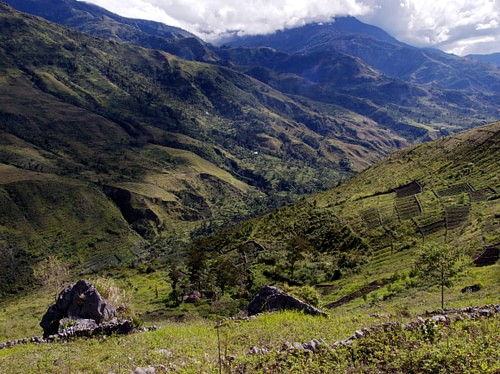
Unfortunately, the exploration of the Papua peninsula is far from easy for a variety of reasons. It is covered with thick rainforests whose humid tropical climate becomes bearable only at 1000 meters (3280 ft) above sea level. Diseases like tuberculosis, hepatitis, typhoid, and malaria are widespread. The natives belong to different ethnic groups with their own cultures, traditions, and languages. Several hundred idioms are spoken in this area whose morphological features account for the fact they live in isolated regions and are not used to meeting foreigners. All these drawbacks prevent explorers and archaeologists from working in the country.
UNESCO has included the native inhabitants of Papua New Guinea among the first populations to practice agriculture on our planet, and Papua New Guinea was listed as a World Heritage Site in 2008.
China: the Yellow River & the Yangtze Valleys
Although archaeological research and activity only began in China in the 20th century, several thousand sites have been explored so far providing evidence of significant and widespread human settlements. Many finds date back to the late Neolithic Age, with a few pre-dating them as far back as 45,000 thousand years ago.
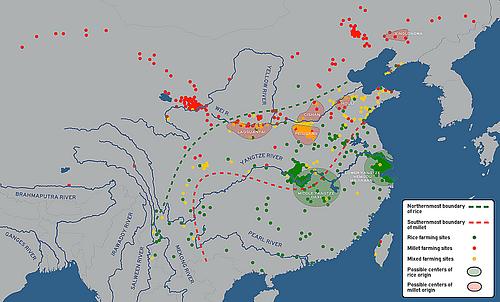
There were two main domestication centres: one in the north along the course of the Yellow River, in an area near the ancient capital Xi'an, where the cultivation of millet, panicle, and brassicas developed side by side with the rearing of dogs, pigs, and poultry, and one further south along the Yangtze Valley, where rice was grown. In fact, the oldest rice phytoliths found along the course of the Yangtze date back to c. 13,900 years ago.
The Fertile Crescent
The Fertile Crescent, that is, the crescent-shaped region spanning most of the Middle East, has long been considered a cradle of agriculture. This theory stems from the large amount of archaeological finds in the area. The domestication of sheep, goats, pigs, and possibly cows, may have been the first step towards sedentary life, followed by the domestication of a few cereals and legumes. The area stretches from the archaeological sites of ancient Jericho in Palestine to the mountainous slopes in southern Turkey, to the southeast as far as Mesopotamia (present-day Iraq and parts of Iran) whereas to the northeast it extends to the shores of the Black Sea and the Caspian Sea.
The plants whose remains have been found in this area include cereals such as barley, different species of emmer, wheat, legumes such as peas and lentils, along with figs, dates, and possibly carob. As for animals, remains of pigs, goats, sheep, and cattle have been unearthed. Remains of dogs have been found as well, but they are likely to have been domesticated for hunting rather than for eating.
Mesoamerica
The Oaxaca Valley in Southern Mexico is traditionally considered where maize was first domesticated from teosinte, its wild progenitor. The combination of archaeological findings and molecular data suggests domestication took place around 9000 years ago. Maize is likely to have spread from the plateau at over 1800 meters (5900 ft) above sea level to the valleys, and from there, to South America principally along the western coast. The domestication of beans seems to be far more recent, dating back to about 4000 years ago.
South America: Peru & the Andean Cordillera
Relevant archaeological sites can be found around Lake Titicaca between Peru and Bolivia and in the Chiloè Archipelago in Chile. Potato, the common bean, and the Lima bean were grown in these areas. Apparently, the potato was domesticated from Solanum brevicaule in southern Peru about 7000 years ago. It then spread both north- and southwards as far as the western coasts of Patagonia (Chile and Argentina), adapting to longer photoperiods, a fundamental evolution that made possible the successful spread of potatoes in Europe.
The domestication of the common bean and the Lima bean may be dated back to 6000 years ago, yet the relevant data need further assessment, above all with regards to the area where the two species of bean were domesticated, as both species are widespread in the area spanning from Central to South America.
North America: the United States East Coast
Plants identified as belonging to the pumpkin, sunflower, and Chenopodium families have been found in archaeological sites along the East Coast of the United States. There has been a long-standing debate on whether the East Coast was an area of domestication in its own right or merely cultivated plants domesticated elsewhere. At present, it appears that species such as Chenopodium, pumpkin, and sunflower were first grown in the area between 3800 and 5100 years ago according to radiocarbon dating.
Sub-Saharan Africa
Given that the genus Homo originated in Africa, it seems likely that humans practiced the earliest forms of agriculture there. However, no evidence to support this theory has yet been found. The oldest known settlement in sub-Saharan Africa, Nabta Playa in southwestern Egypt, dating back to 10,000-8000 years ago, shows remains of livestock, but no remains of plants. The same can be said about Tassili n'Ajjmer, a plateau in the mountainous area in southeastern Algeria, whose numerous rock carvings and paintings show mostly hunting and animal husbandry scenes. In the Nile Valley, sedentary settlements and forms of agriculture, including the cultivation of plants, developed around 5000 BCE and have become well-known worldwide in the past two centuries thanks to paintings found in the various tombs of the Valley of the Kings.
The archaeological sites of Ganjigana and Kursakata in North-Eastern Nigeria, are more interesting, although more recent. The domesticated plants found there are African rice (Oryza glaberrima), millet, and sorghum. African rice is one of the two species of cultivated rice. It can be found only in Africa and is much less widespread than the other species, Oryza sativa, which is typical of Asia. It is thought to have been domesticated about 2500 years ago along the Niger coast, an area in modern-day Mali.
Conclusion
Further research and exploration of new Neolithic farming sites is bound to increase our knowledge in this field. Traces of the cultivation of manioca and pumpkin dating back to 10,000 years ago have been recently found in the Bolivian Amazon. These forms of agriculture developed the cultivation of species native to those areas; innovations were few and mainly due to the exchange of local produce with bordering areas with a similar climate and to the domestication of several new species. This was the state of affairs up to the 16th century.
After the European colonization of the Americas, with the Columbian exchange, species such as potato, maize, cotton, sugar cane, bananas, tea, coffee, cocoa, etc. were taken from the geographical areas in which they evolved and transferred to different parts of the world to create a globally standardized agriculture where a few staple and luxury foods dominated the human and animal nutrition. From the 17th century onwards, change became unpredictable and even upsetting. Colonizers brought species from one continent to another, eradicating them from the geographical areas where they had adapted to the environment over a long evolutionary process to transplant them in other areas of the world on lands taken away from natives. Europeans set up extensive cultivation on amazingly large expanses of land and bent the lives of whole populations to meet the needs of this kind of farming.
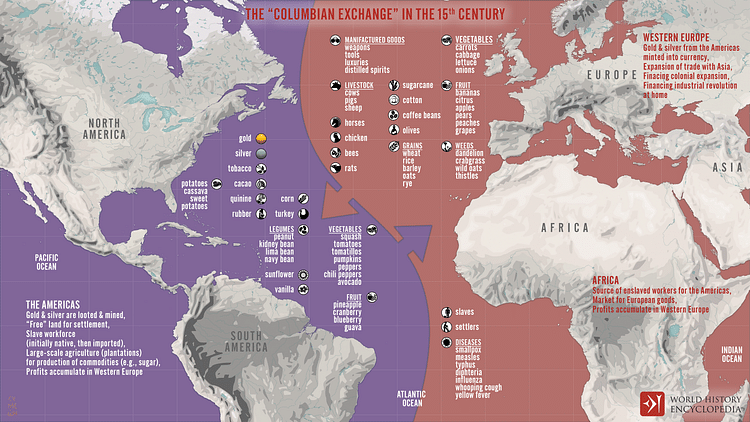
The worldwide spread of crops such as cotton, maize, tobacco, sugar cane, banana, tea, coffee, cocoa, rubber has had positive as well as negative outcomes. The negative effects include catastrophic deforestation in a number of countries around the world (India, the United States, Central America, Brazil, Indonesia), the slave trade from Africa to the New World colonies (12.5 million Africans forcibly assembled and deported to America), the spread of the cultivation of opium as a means to pay the Chinese for tea, involving over one million people, and the standardization of agricultural practice and the worldwide spread of the same few food species.


